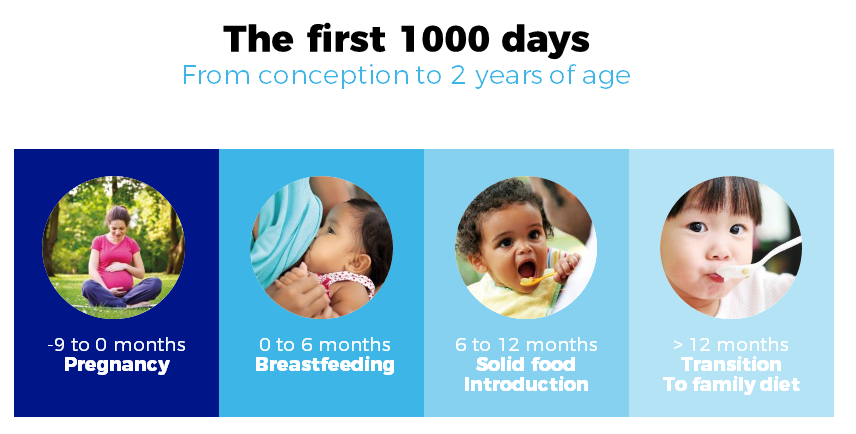Early life, from conception through to our second birthday, is a period of growth and development more rapid and significant than at any other stage of our lives. Since all of our 1Hanson, et al. Published on 2009 organs and tissues are being formed and educated during this time, it offers a unique window of opportunity to shape our lifelong health.

-9 months to 0 months: pregnancy
A healthy balanced diet before conception and during pregnancy will help nourish the growing foetus and build optimal body reserves in preparation for breastfeeding. Furthermore, evidence now shows that an imbalance of macro- and micronutrients during pregnancy can programme a child to develop non-communicable diseases later in life.2Hanson, et al. Published on 2009 This suggests that, in order to promote the short- and long-term health outcomes of both mother and child, it is essential to have a balanced and nutritious diet, together with a healthy lifestyle, during pregnancy.
Vitamins D, B2, B6, B12, folic acid, choline and the minerals such as iron, iodine and calcium are particularly important during pregnancy.4WHO, Published on 2011 ,5Van Hees, et al. Published on 2013 ,6Yajnik, et al. Published on 2008 Other nutrients for e.g. omega 3 fats are also important to include in the mother’s diet since they are known to play a significant role in the development of the baby’s brain.7Carlson, Published on 2009

At Danone Research & Innovation, we aim to develop products that support a mother’s health, which in turn can positively affect the growth and development of the foetus. The nutrition a foetus receives from its mother can influence gene expression, profoundly impacting the long-term health of the child.
A mother’s microbiota plays an important role in maintaining not only her own health but also the early colonisation of microbiota in her infant’s gastrointestinal tract – through natural birth delivery and breastfeeding.8Martin, et al. Published on 2010 Danone Research & Innovation studies maternal diet and its influence on maternal microbiota. Our aim is to support the development of healthy microbiota in pregnant and lactating women through appropriate nutritional interventions nutrition.
0-6 months: breastfeeding
Danone Research & Innovation supports the WHO’s public health recommendation in favour of exclusive breastfeeding for the first six months, and continued breastfeeding up to two years along with the gradual introduction of safe and suitable solid foods.

We believe that Human milk is the best source of nourishment for all infants worldwide. It contains the right balance of nutrients and bioactive components to ensure the optimal growth and development of the body and its organs, including the immune system and gastrointestinal microbiota. In addition, breastfeeding is associated with many short- and long-term health benefits for both infant and its mother.9WHO, Published on 2007

At Danone Research & Innovation we have spent over 40 years analysing the complex composition and structure of human milk, seeking to unravel its benefits in order to support breastfeeding. Through our state-of-the-art equipment, as well as our dedicated research teams, we aim to understand the influence of diet on the composition of breastmilk.
The nutritional impact of lactation on maternal stores is even greater during pregnancy and requirements are higher for a number of nutrients, e.g. vitamin A, iodine, vitamin C, vitamin B12, vitamin B6, vitamin B2, zinc. Lactating mothers should consume nutrient rich foods. A nutritional supplement may be recommended by their healthcare professional to help meet the increased requirements of some nutrients.
6-12 months: solid food introduction
Milk alone is no longer adequate since infants have increased nutritional needs beyond 6 months of age.
The introduction of complementary foods is also important to develop the acceptance of different food textures and tastes, the foundation of healthy eating habits; this phase is therefore about more than just ‘providing energy’.10Cashdan, Published on 1994 ,11Agostini, et al. Published on 2008 ,12Schwartz, et al. Published on 2011
Choosing the right type and variety of complementary foods exposes babies to a large variety of tastes and textures. This helps establish healthy food preferences and shape lifelong eating habits.13Nicklaus, Published on 2011

Learn more about the importance of complementary foods taste, texture and appearance here.
Danone Research & Innovation aims to provide complementary foods in a variety of tastes and textures appropriate for each developmental stage of a child.
>12 months: transition to family diet
Toddlers need up to seven times more of some specific nutrients compared to an adult (per kg body weight) to support the rapid development that continues through childhood. This means that with every spoon a child has to eat significantly more (micro)nutrients than an adult. Therefore it is important to receive nutrient dense foods as opposed to energy dense foods.14Noridic Council of Ministers, Nordic Nutrition Recommendations 2012. Integrating nutrition and physical activity. 5th Edition, Published on del

A toddler’s specific nutritional requirements may not always be met by a regular family diet, particularly in the provision of nutrients such as iron, zinc, vitamin D and essential fatty acids. Moreover, high levels of protein and salt in adult diets may be unsuitable for young children. Providing young child formulae or toddler milks as part of a balanced diet can be an effective food based strategy to address these nutrient imbalances.
Toddlerhood is a period of life characterised by a gain of autonomy resulting from the development of motor skills and a change in the relationship with parents. Parental feeding styles can therefore have a profound impact on later eating behaviour.

Toddlerhood provides an important opportunity to establish lifelong healthy eating habits.
View References
| 1, 2, 3 | Hanson, et al. Published on 2009 |
|---|---|
| 4 | WHO, Published on 2011 |
| 5 | Van Hees, et al. Published on 2013 |
| 6 | Yajnik, et al. Published on 2008 |
| 7 | Carlson, Published on 2009 |
| 8 | Martin, et al. Published on 2010 |
| 9 | WHO, Published on 2007 |
| 10 | Cashdan, Published on 1994 |
| 11 | Agostini, et al. Published on 2008 |
| 12 | Schwartz, et al. Published on 2011 |
| 13 | Nicklaus, Published on 2011 |
| 14 | Noridic Council of Ministers, Nordic Nutrition Recommendations 2012. Integrating nutrition and physical activity. 5th Edition, Published on del |


